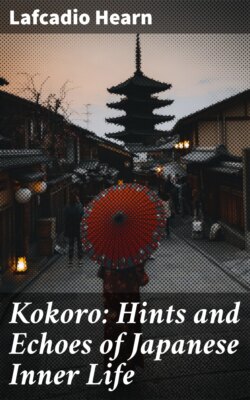Читать книгу Kokoro: Hints and Echoes of Japanese Inner Life - Lafcadio Hearn - Страница 17
На сайте Литреса книга снята с продажи.
IV
ОглавлениеKYOTO, April 10–20.
I have passed the greater part of three days in the national Exhibition—time barely sufficient to discern the general character and significance of the display. It is essentially industrial, but nearly all delightful, notwithstanding, because of the wondrous application of art to all varieties of production. Foreign merchants and keener observers than I find in it other and sinister meaning—the most formidable menace to Occidental trade and industry ever made by the Orient. "Compared with England," wrote a correspondent of the London Times, "it is farthings for pennies throughout. … The story of the Japanese invasion of Lancashire is older than that of the invasion of Korea and China. It has been a conquest of peace—a painless process of depletion which is virtually achieved. … The Kyoto display is proof of a further immense development of industrial enterprise. … A country where laborers' hire is three shillings a week, with all other domestic charges in proportion, must—other things being equal—kill competitors whose expenses are quadruple the Japanese scale." Certainly the industrial jiujutsu promises unexpected results.
The price of admission to the Exhibition is a significant matter also. Only five sen! Yet even at this figure an immense sum is likely to be realized—so great is the swarm of visitors. Multitudes of peasants are pouring daily into the city—pedestrians mostly, just as for a pilgrimage. And a pilgrimage for myriads the journey really is, because of the inauguration festival of the greatest of Shinshu temples.
The art department proper I thought much inferior to that of the Tokyo Exhibition of 1890. Fine things there were, but few. Evidence, perhaps, of the eagerness with which the nation is turning all its energies and talents in directions where money is to be made; for in those larger departments where art is combined with industry—such as ceramics, enamels, inlaid work, embroideries—no finer and costlier work could ever have been shown. Indeed, the high value of certain articles on display suggested a reply to a Japanese friend who observed, thoughtfully, "If China adopts Western industrial methods, she will be able to underbid us in all the markets of the world."
"Perhaps in cheap production," I made answer. "But there is no reason why Japan should depend wholly upon cheapness of production. I think she may rely more securely upon her superiority in art and good taste. The art-genius of a people may have a special value against which all competition by cheap labor is vain. Among Western nations, France offers an example. Her wealth is not due to her ability to underbid her neighbors. Her goods are the dearest in the world: she deals in things of luxury and beauty. But they sell in all civilized countries because they are the best of their kind. Why should not Japan become the France of the Further East?"
The weakest part of the art display is that devoted to oil-painting—oil-painting in the European manner. No reason exists why the Japanese should not be able to paint wonderfully in oil by following their own particular methods of artistic expression. But their attempts to follow Western methods have even risen to mediocrity only in studies requiring very realistic treatment. Ideal work in oil, according to Western canons of art, is still out of their reach. Perhaps they may yet discover for themselves a new gateway to the beautiful, even through oil-painting, by adaptation of the method to the particular needs of the race-genius; but there is yet no sign of such a tendency.
A canvas representing a perfectly naked woman looking at herself in a very large mirror created a disagreeable impression. The Japanese press had been requesting the removal of the piece, and uttering comments not flattering to Western art ideas. Nevertheless the canvas was by a Japanese painter. It was a daub; but it had been boldly priced at three thousand dollars.
I stood near the painting for a while to observe its effect upon the people—peasants by a huge majority. They would stare at it, laugh scornfully, utter some contemptuous phrase, and turn away to examine the kakemono, which were really far more worthy of notice though offered at prices ranging only from ten to fifty yen. The comments were chiefly leveled at "foreign" ideas of good taste (the figure having been painted with a European head). None seemed to consider the thing as a Japanese work. Had it represented a Japanese woman, I doubt whether the crowd would have even tolerated its existence.
Now all this scorn for the picture itself was just. There was nothing ideal in the work. It was simply the representation of a naked woman doing what no woman could like to be seen doing. And a picture of a mere naked woman, however well executed, is never art if art means idealism. The realism of the thing was its offensiveness. Ideal nakedness may be divine—the most godly of all human dreams of the superhuman. But a naked person is not divine at all. Ideal nudity needs no girdle, because the charm is of lines too beautiful to be veiled or broken. The living real human body has no such divine geometry. Question: Is an artist justified in creating nakedness for its own sake, unless he can divest that nakedness of every trace of the real and personal?
There is a Buddhist text which truly declares that he alone is wise who can see things without their individuality. And it is this Buddhist way of seeing which makes the greatness of the true Japanese art.
